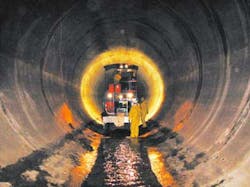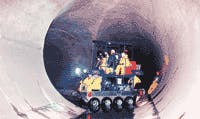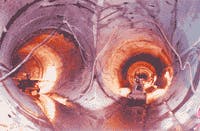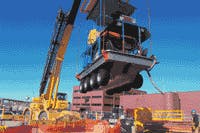Milwaukee Inspects Wastewater Storage, Conveyance System
After eight years of operation, the first manned inspection of Milwaukee's 405 million gallon wastewater storage and conveyance system found the storage system very much in solid shape. In fact, so good that some original spray paint markings used as guides during construction in the late 1980s and early 90s are still visible on the tunnel walls, according to representatives of the Milwaukee Metropolitan Sewerage District.
"Structurally, it's in great condition," said Kevin Shafer, director of technical services for MMSD. "In many areas, it's in as good of shape as the day it was put into operation."
The MMSD Commission awarded a $1.2 million inspection contract to Rust/Harza, a joint venture of three Milwaukee-area engineering consulting firms. The sewerage district encompasses about 420 square miles and serves 1.2 million residents in 28 municipalities.
While no known operational concerns regarding the Inline Storage System's (ISS) condition existed, the system had not been entirely inspected since being placed into operation in 1994.
In January, a team of experts ventured 300 feet below ground to begin inspecting and videotaping the 19.4-mile wastewater storage and conveyance system. The crew consisted of a safety director, foreman to operate the inspection vehicle, geotechnical expert, engineering technician and video camera operator. Contractors completed the inspection in mid February with some new insight into the challenges a project like this poses.
"This method of inspection is considered superior to a remote camera inspection, as it allows geotechnical engineers to visually focus on features at the time of inspection rather than providing analysis of a video graphic image," Shafer said.
The videotape will be compared with video taken in late 1993 just prior to the opening of the tunnel system. Rust/Harza will prepare a report on the condition and make recommendations. The final report will be completed by midyear.
The inspection team used a specially outfitted 8-wheel-drive transporter capable of maneuvering through 16 inches of water to document two to three miles of tunnel conditions each day. Also designed to float if necessary, the vehicle stands more than 12 feet tall and weighs 5,000 pounds (without crew weight). In addition, the transporter had its own generator/power supply, floodlights and was outfitted with an observation deck for the video camera.
In the event an emergency evacuation was necessary, a six-wheeled vehicle was placed at the surface of the nearest access point to where the crew was working that day. If needed, specially trained fire department emergency team members were on alert to use the second vehicle to reach inspectors in the tunnel.
From the start, the district's main concern was safeguarding crews venturing inside the tunnel, which is a full football field's length below ground and varies in diameter between 17 and 32 feet.
"Safety remained our highest priority for this important project," said MMSD Commission Chairman Antonio Riley, a state representative from Milwaukee. "The contractor proposed an extensive safety plan and assured us that all safety systems were backed up by secondary systems."
Besides making sure the $800 million ISS was structurally sound, the goals of the inspection were to determine if there was any debris in the tunnel as well as measure the amount of groundwater infiltration into the tunnel system during dry weather. To accomplish that goal, the crew stopped every 2,000 feet to measure and document the volume and flow rate of water in the tunnel. The system was designed to handle about 6 million gallons of infiltration per day and preliminary estimates indicate the actual infiltration is well below that level.
Workers found silty, sandy sediment on the bottom of the ISS in several areas, but nothing that was unexpected. What they did not expect, however, was difficulty maneuvering their 8-wheeled vehicle through some of the sediment.
"Even with the limited amount of sediment that was found, the contractor had to lower a tracked machine into the tunnel to help push or pull the wheeled inspection vehicle through the sediment," said Tim Bate, a senior engineer and section manager for MMSD.
Other challenges for the project included what many would consider the simple task of communicating from the surface to the crew inside the ISS. The contractor did not feel comfortable relying on two-way radio communications. Instead, the crew used three separate modes: a hard-wired phone system; two-way radios; and air horns for backup emergency communications.
The project remained on schedule even though the original timetable did not include the downtime required each day to retrieve the hard-wired phone system. The crew would lay the phone system as it progressed through the tunnel and then take a day to retrieve the phone line before moving on to the next segment.
The inspection project was performed in three phases, with the first measuring the amount of groundwater infiltrated on a daily basis. Phase two consisted of preliminary man-entry at two access shafts to determine tunnel conditions that could be encountered during the full inspection, and the third phase included the manned inspection with videotaping.
Overall, the inspection team was pleased with the safety conditions found inside the ISS. Ventilation and airflow were extremely positive; so much so, it was actually a little windy inside the tunnel, inspectors said.
The ISS is designed to capture excess wet weather flows and prevent sewer overflows to area waterways. Since inception, it has prevented more than 250 overflows and 40 billion gallons of untreated wastewater from entering Milwaukee-area waterways. Before the system went on-line, there were 50 to 60 sewer overflows annually. Since 1994, that average has declined to 2.5 overflows a year.
"This environmental asset has provided tremendous benefits to the community and helped improve the water quality of area rivers and Lake Michigan," Riley said. "Just like going to the doctor or dentist for regular checkups to make sure you're healthy, it was vitally important that we take preventative steps to make sure the ISS is healthy for the next 50 to 75 years for future generations."




